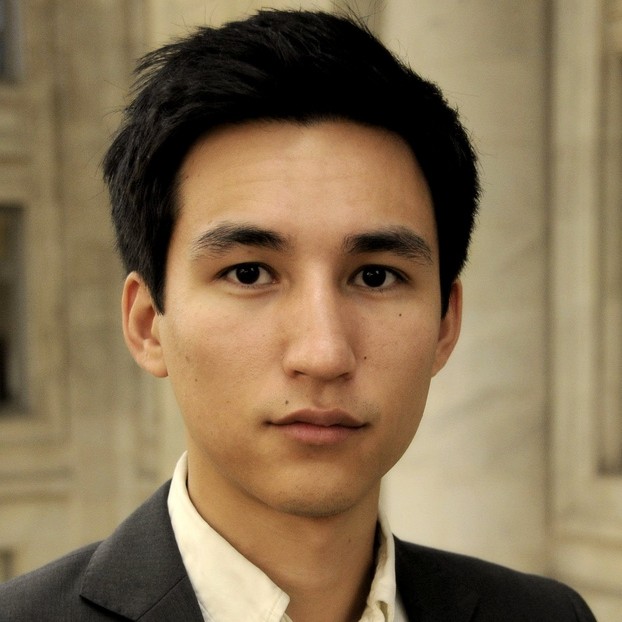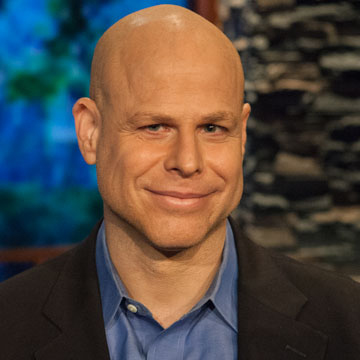
Top left: A Medicare for All rally in Los Angeles in February 2017. (Photo by Molly Adams/ flickr CC 2.0) Top right: Bryant Moya, his mother, Ingrid Encalada Latorre, and brother Anibal Jurado in their room at Foothills Unitarian Church in Fort Collins, Colorado on Oct. 17, 2017. Latorre was scheduled to be deported to Peru but re-entered sanctuary with her sons. (Photo by Joe Amon/The Denver Post via Getty Images) Bottom: Workers at Salaam Hospital transport usable medical supplies and equipment from the destroyed hospital on Feb. 1, 2017 in east Mosul, Iraq. The hospital was targeted by a US coalition airstrike in December 2016 as it was a base for Islamic State commanders. (Photo by Martyn Aim/Corbis via Getty Images)
This time every year, BillMoyers.com asks reporters, editors and bloggers which key story they feel the mainstream media failed to cover adequately over the last 12 months. See what they had to say.
Donald Trump’s Conflicts of Interest

Ben Adler
The most overlooked story this year continues to be Trump’s conflicts of interest and the lack of legal mechanisms to protect the executive branch of the federal government from corruption. In 2016, the press — with the exception of Kurt Eichenwald at Newsweek — ignored the vast web of global business interests and questionable connections that Trump and his company had and how they might conflict with American foreign policy interests. We completely failed to note that Trump was constitutionally ineligible to serve if he did not fully divest from his business, as he would be in violation of the Constitution’s emoluments clause. Since the election, outlets such as The New York Times, The Washington Post, Reuters and The New Yorker have covered various conflicts of interest for Trump, his family members and his unpaid advisers such as Carl Icahn and Jared Kushner.
But TV, the most popular medium from which Americans get their news, remains relentlessly focused on the sexier topics of the day. That’s often just what Trump tweeted. Sometimes, as when he’s tweeting provocations to North Korea, that’s an important news story. Other times, as when we’re being distracted by the president’s insults to the appearance of a talk show host, it’s not. In any case, the complicated connections between the personal financial interests of Trump, his White House staffers, family and associates and the policies being promulgated at the White House remains under-illuminated. As Public Citizen recently noted, but few journalists picked up on, even standard Republican deregulation of labor and the environment raises new ethical questions when Trump’s own business stands to profit from it.
Moreover, we have discovered, too late, that many of the safeguards rely upon public officials’ voluntary compliance. Trump violated norms, but no laws, by not releasing his tax returns. His staffers and cabinet appointees may have broken laws by promoting Trump brands and campaigning on behalf of elected officials, but no one in the Trump administration seems interested in enforcing those laws. The press should be not only examining these problems, but their potential solutions.
— Ben Adler, New York-based journalist
Everything That Wasn’t a Trump Tweet

Dahlia Lithwick
In my view, the most under-reported story of the year was everything. I mean, quite literally, everything that wasn’t a Trump tweet. We didn’t do a good enough job covering DACA (Deferred Action for Childhood Arrivals), refugees after the first travel ban, the oral arguments of the third travel ban, the creeping encroachments on reproductive freedoms in the states and systematic vote suppression.
We surely didn’t do a good job on Trump’s efforts to stack the judicial branch with unqualified bloggers, who by experience and temperament had no business even being before the judiciary committee. We episodically covered the opioid epidemic, the ways big think tanks have infiltrated government, the treatment of veterans… I could go on and on.
But here’s the thing: Scolding one another for missing the real story for the “distractions” is its own form of blaming and shaming. Attacks in the media are destabilizing enough without constant criticisms that we are all missing the real story. Everything is the real story, up to and including presidential tweets, which like it or not are official acts. My gift to myself and to you as readers is the fact that there is no monolithic “mainstream media” that is ignoring the important issues by design. It is simply true that the Bannon Chaos Machine works best when absolutely every story is the 25th most important story of the day, and everyone is wasting energy scolding others for their lack of focus. We need not play into this.
We can operate from a “yes, and” lens, acknowledging that the media misses a lot of big stories precisely because it’s covering a lot of other big stories. I could wish that we were less obsessed with individual journalists and their brands. But boy, do we owe a debt of thanks to the “yes, and” journalists who uncovered Roy Moore’s predation and the conflicts of interest in the Trump family. This year I say yes, and let’s cover all of it better and deeper. And let’s thank journalists for the work they do, and use our own voices to amplify the stories that cannot break through. I am not going down the shame-framing road this year. It’s all important to somebody. I am grateful it’s getting done at all.
— Dahlia Lithwick, writer and podcast host, Slate
US Airstrikes in Iraq

Danielle Ivory
In a year packed with excellent, important and outrage-inducing reporting, a deep story about airstrikes against ISIS in Iraq did not get nearly enough attention.
In The Uncounted, Azmat Zahra and Anand Gopal visited 150 US airstrike sites in Iraq, providing the first systematic, ground-based sample of airstrikes there since the latest military action began in 2014.
They found that the civilian death rate was 31 times higher than the American-led coalition fighting the Islamic State has previously claimed — making this, possibly, the least-transparent war in recent American history. They also found that civilians who survived the strikes were repeatedly classified as being ISIS sympathizers, with no clear path to clear their names.
— Danielle Ivory, business reporter, The New York Times
The Whereabouts of Our Military Personnel

Tom Engelhardt
Excuse me if, year after year, I’ve started to sound like a broken record, but when it comes to the missing stories of 2017, the one I always focus on — the one that was similarly AWOL in 2016, 2015 and so on — concerns America’s wars. Yes, they’re in the news as a kind of low-level hum in the background of our media lives. Afghanistan (yawn…), another more than 3,000 (or is it 4,000?) troops have been dispatched to join the 8,400 (or is it 12,000?) who were there as the Obama years ended (and don’t even think about the 26,000 private contractors working for the US in that country). Syria — yep, 500 American troops still fighting there (or rather maybe it’s actually 2,000). And OK, across the Middle East and increasingly Africa, great cities are in ruins, the foundations of multiple societies wrecked and failed states a dime a dozen, but no point in making too big a deal out of it.
And what about those 44,000 American troops reportedly stationed somewhere in the imperium but who knows where because the Pentagon claims it just can’t account for them? (And perhaps that’s not so surprising for a place that has never been capable of successfully auditing itself.) Or how about those 70,000 US Special Operations forces, that semisecret military that’s larger than the armies of a surprising number of countries and whose troops are deployed to more lands yearly (149 in 2017, according to Nick Turse of TomDispatch) than any great power has ever sent its forces to. And of course there’s the rising beat of Trump-era drone strikes, air strikes (hey, shades of Vietnam, the last B-52s have been let loose in Afghanistan!), special ops raids, dead civilians… and so on.
And yes, if you’re a news jockey or a war jockey and you’re searching oh-so-carefully, day by day, it’s all there somewhere (hence the links above), but war — permanent war across a vast swath of the planet, now in its 17th year and increasingly thought of by the US military as “generational” (i.e. forever) — well, no. It’s not really a story story. It’s never put together in a truly meaningful way in the mainstream. It’s just not really there. Not there there. Not where any passing Trump tweet is in the news; not where the latest ISIS-inspired doofus who hit a subway stop in my hometown with a suicide bomb that didn’t quite work is; not where the president’s denunciations of NLF players who take a knee regularly are.
War on our distant battlefields is the oh-so-distant backdrop for our oh-so-immediate lives. It’s not what any of the media outlets now assigning battalions of reporters to swarm every presidential hiccup or burp find worthy of significant attention. Only problem is: Our wars are changing this planet and our own lives in ways hard to make tweetable but oh-so-consequential in the long run. Our wars need to be covered, as our president might say, bigly. (Or was it “big league”?) Once again, in 2017, they were largely missing in action.
— Tom Engelhardt, editor, TomDispatch
Trump’s Lasting Policy Legacy

Lee Fang
There’s simply been too little attention to the ways that the Donald Trump administration has ruthlessly worked to remake American society. Many decisions have been designed to radically restructure our political system, and will continue with us well after Trump leaves office.
This presidency has acted decisively to make good on the biggest priorities of corporate America and the wealthiest upper echelons of society in three areas:
(1) Remaking the regulatory state. The Trump administration has not only defanged environmental policy for a generation and moved to push out scores of talented public servants, but has used an obscure congressional rule to ensure that new safeguards on privacy, workplace safety, consumer protections and beyond will be difficult to implement in the future.
(2) Taking over the judiciary. Trump has moved swiftly fill the federal bench with far right, business-friendly judges, at a rate easily on track to outpace judicial appointments of any modern administration. The takeover means that progressive policies and legal battles over the next ten to thirty years will likely be in the hands of Trump era judges.
(3) Accelerating inequality. Though he promised to return power to the “forgotten men and women of our country,” Trump’s greatest legislative achievement may well be his tax cut, a legislative freight train that barreled through with virtually no public input, no serious debate, and transparently designed to comfort the comfortable and afflict the afflicted. The bill enriches the pinnacles of privilege on Wall Street and Silicon Valley, along with provisions that benefit real estate developers such as Trump and the fossil fuel barons that funded his presidential campaign, while offering peanuts for the poor and working class, many of whom will in fact face a tax hike in a few years given the design of the legislation.
There’s been no shortage of Trump news and scandal. But the news media should be careful not to be distracted away from highlighting how this administration is working hand in glove with a power elite to fundamentally remake American society.
— Lee Fang, investigative journalist, The Intercept
The Growing Movement for Medicare for All

Maya Schenwar
This year, most news media outlets devoted at least a modicum of coverage to Republicans’ brutal attacks on the ACA and Medicaid. However, corporate media failed utterly in covering a key aspect of the health-care story: the groundswell of support for single-payer care. This year saw record backing for single-payer bills in the House and Senate, and a ramping up of state-level proposals in California, New York, Massachusetts and beyond. Moreover, public enthusiasm for single-payer has surged; polls show a majority of Americans supporting it. Truthout has been covering these developments, and the grass-roots organizing that has driven them, in our feature “Fighting for Our Lives: The Movement for Medicare for All.”
The struggle for single-payer has been a coalitional effort, bringing together activists working on issues from racial justice to veterans’ rights to reproductive justice to elder rights to disability justice, and more. It has also become a vehicle for progressive candidates to challenge establishment Democrats in primaries. It’s vital to cover the devastating ways in which the GOP is attacking the health care we already have. However, it’s also crucial that we as journalists also take heed of the historic push for full health care access for all.
— Maya Schenwar, editor-in-chief, Truthout
Real Life, Everyday People
I do not need to see another “think piece” about about why white women voted for Roy Moore or Trump, read yet another exploration into the new face of white nationalism supremacy or hear again why coal miners believe immigrants are the cause for all their economic woes (though this is a good one).
I just don’t.
The most under-reported story of 2017 is the same story that has gone under-reported for more than a decade: Any story with everyday Americans working to make ends meet at the center of said story.
What America needs to see more of, what it needs to be confronted with, are the lived experiences of those who are the objects of hate and targets of dangerous US government actions such as Trump’s deportation policies, which are tearing families apart the likes of what America has not seen since the trans-Atlantic slave trade. These are real-life consequences for real people, and are under-reported in US news. I want to see their faces, experience their day, hear what they hear and be able to step into their lives and see myself. I can’t do that if journalists continue to hyperfocus on the powerful to the exclusion of the average.
All too often journalists put powerful actors and inside baseball at the center of their coverage. What that does is perpetuate cynicism — inside and outside of Capitol Hill the White House and statehouses. But by making real-life, everyday people our focus, journalists just might help this country see what we have in common, rather than continue to contribute to what divides us.
And to that end… Working class Americans aren’t just white.
It’s not the “urban vote” that turned out in the Alabama Senate race. You likely mean black voters, but should acknowledge that white voters live in urban areas too. In fact, they are taking over many urban areas — aka inner cities. And for good measure, black voters don’t just live in inner cities.
Stop calling people of color minorities. Our job as journalists is to observe and report accurately. Look around a lot of places and reporters will find that people of color are actually the majority.
Words matter. Language and truthful news coverage will be just as critical in 2018 as it was in 2017. More so, actually.
— Tracie Powell, founder, All Digitocracy and senior fellow, Democracy Fund
America’s New “Special Government Employees”

Joshua Holland
In the chaos of the early days of the Trump administration, one story that got little attention was the White House’s strategy of circumventing the Senate confirmation process to appoint people with dubious credentials, past histories of controversy or apparent conflicts of interest to key positions throughout the government.
The White House accomplished the feat either by naming people as “Special Government Employees” — essentially specialists who are supposed to serve on a temporary or part-time basis — or by giving them jobs as “acting” directors of various federal agencies. These included an “interim” head of the Office of Government Ethics who had devoted a career to trying “to roll back or loosen ethics requirements on federal employees,” according to The New York Times, and various industry lobbyists appointed to regulate their former clients. But under federal law, “acting” officials can only serve up to 300 days, unless a permanent replacement is awaiting Senate confirmation, and last month David Dayen reported for The Intercept that a number of these appointees have “quietly” dropped “acting” from their titles, and Josh Eidelson reported for Bloomberg that others may find themselves facing legal challenges in the near future.
— Joshua Holland, contributing writer, The Nation
The Lasting Economic Impacts of Immigration

Simon Johnson
In early August, President Trump announced his support for legislation proposed by Republican Sens. Tom Cotton (AR) and David Perdue (GA) which could cut legal immigration to the United States by about half — from 1 million to 500,000 people per year.
Immigrants work hard and have helped build this nation. They tend to arrive relatively young and to have more children than people born in the United States. They pay taxes and help support social security and other programs. If you want robust economic growth — as Trump claims he does — you should keep the door open to immigrants. If you want to admit a large number of already-educated people — which is what Sens. Cotton and Perdue claim — then this could be accommodated on top of the existing inflow.
A lot of attention has been devoted this year to Republican attempts to repeal the Affordable Care Act and to cut corporate taxes — neither of which will have anything like the pro-growth effects that are claimed. We should have more coverage and analysis of proposals that would cut legal immigration; such steps would definitely slow the economy and put a significant dent in our prosperity.
— Simon Johnson, MIT economist and blogger, BaselineScenario.com
A Solution to Sexual Harassment—from Farmworkers

Greg Kaufmann
The most uncovered story of the year is also an unlikely one — a story of success in the fight against sexual violence in the workplace. It comes out of Florida’s tomato fields, known less than a decade ago as “ground zero for modern slavery.” It offers lessons for women and men in workplaces everywhere, as well as a solution that could make 2017 the turning point in the history of sexual harassment and assault at work.
The Coalition of Immokalee Workers’ (CIW) Fair Food Program is putting a stop to workplace sexual abuse in a world where fully 80 percent of women farmworkers report having experienced harassment or assault. The plan was developed by the farmworkers themselves, historically one of the most powerless groups of workers in America. They do it through a combination of worker-to-worker education, a 24-hour hotline and an independent monitor that investigates complaints — all backed by real economic consequences for violations that go uncorrected.
The program’s code of conduct demands that human-rights standards are adhered to, including zero tolerance for sexual assault, and more than 90 percent of Florida’s $600 million tomato industry has signed on. That’s because the CIW has struck binding agreements with 14 of the world’s largest retail food corporations — including all major fast-food companies with the exception of Wendy’s — saying they will only buy tomatoes from farmers that are in the program, and they won’t buy produce from farms that are in violation of the code of conduct. In the past several years, 23 supervisors have been disciplined as a result of sexual harassment complaints, and nine have been fired.
In one episode of the PBS investigative series FRONTLINE, called “Rape in the Fields,” the producer said CIW’s Fair Food Program was “unique in the country” because it was “the first time that we saw an economic incentive placed on anti-sexual harassment policies.”
In the end, if you want to ensure that the workplace changes, hit predators and their enablers in a place they won’t ignore: their bottom line.
— Greg Kaufmann, editor, TalkPoverty.org

